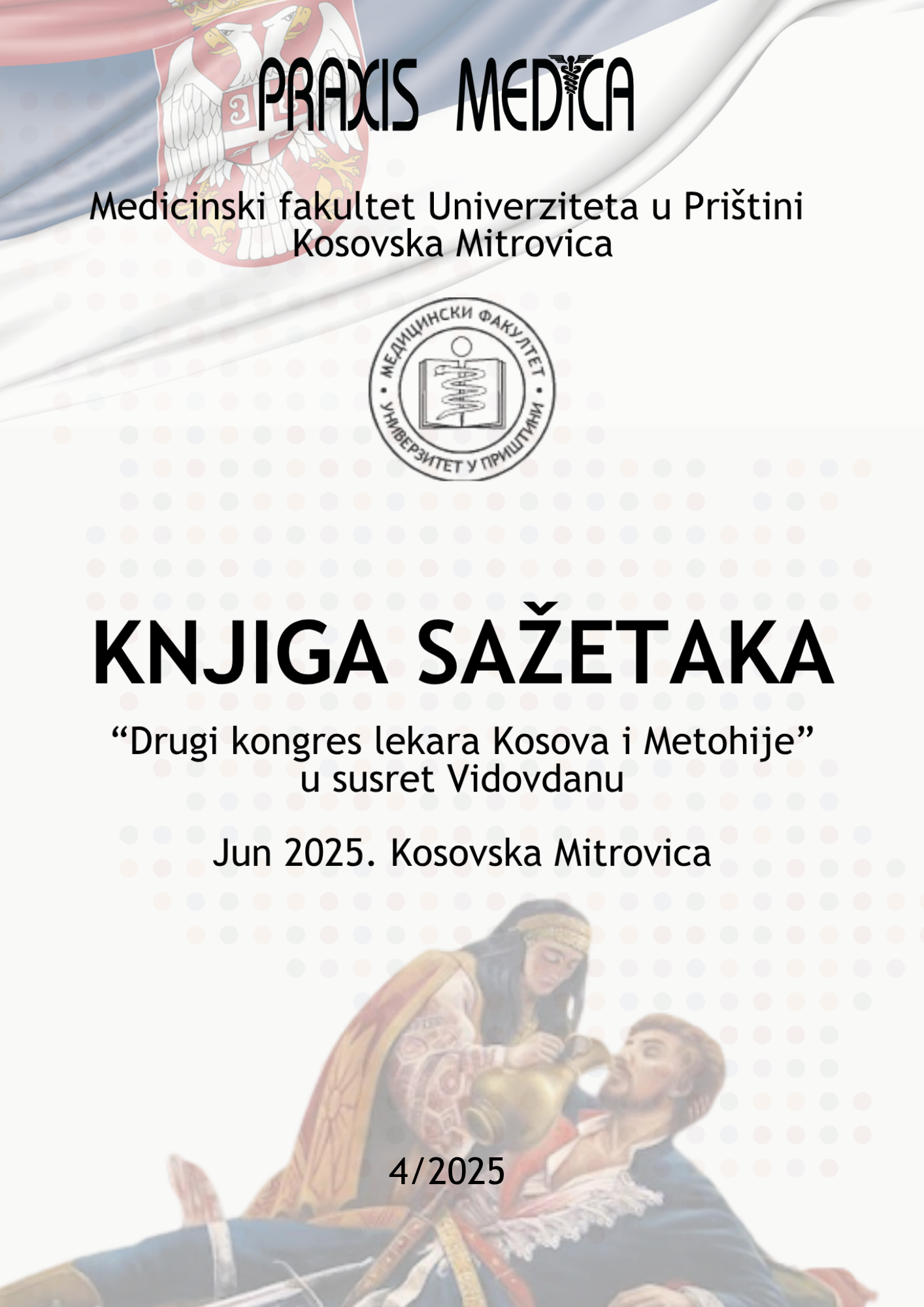Current issue

Volume 53, Issue 4, 2025
Online ISSN: 2560-3310
ISSN: 0350-8773
Volume 53 , Issue 4, (2025)
Published: 30.06.2025.
Open Access
All issues
Contents
30.06.2025.
Professional paper
SRČANA SLABOST I GOJAZNOST
Kao posledica nepravilne ishrane i sedentarnog načina života broj gojaznih osoba dobija epidemijske razmere. Brojne studije pokazuju da je povišen
indeks telesne mase (BMI) nezavistan faktor rizika za nastanak kardiovaskularnih bolesti, uključujući i srčanu insuficijenciju.
Povećanje indeksa telesne mase je udruženo sa povećanim rizikom od pojave srčane slabosti (sistolne i dijastolne) kod osoba oba pola. Naime,
gojaznost je povezana sa češćom hipertrofijom leve komore i njenom dilatacijom, što su prekursori srčanog popuštanja. Usled prisutnog metaboličkog
sindroma kod gojaznih je češća pojava koronarne bolesti. Prevalencija diabetesa, arterijske hipertenzije i hiperlipoproteinemija raste sa porastom
indeksa telesne mase, a oni su faktori rizika za pojavu koronarne bolesti, koja je najčešći uzrok pojave srčane insuficijencije. Pored toga, dijabetes i
arterijska hipertenzija nezavisno povećavaju rizik od nastanka srčane insuficijencije. Povišen BMI udružen je sa izmenjenim remodelovanjem i
hipertrofijom leve komore (verovatno zbog povećanog hemodinamskog opterećenja), neurohormonalnom aktivacijom (povećana simpatička aktivnost,
aktivnost renin-angiotenzin sistema i dr.) i povećanim oksidatvnim stresom. Poslednjih godina ističe se značaj masnog tkiva kao endokrinog organa
koji oslobađa širok spektar biološki aktivnih materija koje mogu imati kardiotoksično dejstvo. Postoji više mogućih mehanizama kojima gojaznost
direktno može dovesti do pojave srčane insuficijencije: gojaznost uzrokuje akumulaciju lipida u ili oko miocita, a oni produkuju lipotoksine sa
direktnim toksičnim efektom na miocite; gojaznost indirektno uzrokuje insuficijenciju desne komore, zbog restriktivne bolesti pluća i poremećaja
disanja tokom sna (sleep apnea); gojaznost je hronično inflamatorno stanje, a inflamatorni citokini mogu narušiti kardijalnu funkciju i/ili izazvati
fibrozu (metaflamacija). Simptomi i znaci SI se naročito teško utvrđuju kod gojaznih, pa se dijagnoza srčane insuficijencije često ne postavlja na
vreme. Gojaznost i terapija srčane slabosti mogu uticati na niže nivoe natriuretskog peptida. Redukcija telesne težine, promena načina života i
ishrane, kao i prevencija dijabetesa kod gojaznih osoba, može značajno redukovati rizik od nastanka srčane insuficijencije. Redukcija telesne težine
dijetom, barijatrijskom hirurgijom ili lekovima (inkretinski hormoni) kod izrazito gojaznih osoba može sprečiti pojavu i poboljšati tok SI. S druge
strane, gojazni, suprotno prvobitnim očekivanjima, često imaju bolju prognozu srčane insuficijencije od negojaznih (obesity paradox). Terapija
srčane insuficijencije kod gojaznih se sastoji iz opštih mera lečenja, medikamentne terapije, invazivnih kardioloških terapijskih mera, kao i hirurškog
lečenja. Primena SGLT2 inhibitora, sakubitril/valsartana i spironolactona imaju posebno povoljan efekat u terapiji srčane insuficijencije kod
gojaznih. Određeni lekovi za terapiju hipertenzije ili dijabetesa, kao što su ACE inhibitori i metformin posebno su efikasni za lečenje i sprečavanje
nekih od posledica ovih bolesti kod gojaznih, a time mogu smanjiti rizik od nastanka srčane insuficijencije. Druga terapija kao što je antiagregaciona
terapija, statini ostvaruju terapijski cilj sprečavanjem nastanka i progresije koronarne bolesti srca,
S obzirom na veliki broj nepoznanica koji prati ovu temu, očekuje se da će buduća istraživanja potpuno razjasniti sve do sada nedovoljno poznate
karakteristike srčane insuficijencije kod gojaznih osoba i da će otvoriti nove terapijske mogućnosti u tretmanu ovih osoba.
Ključne reči: Srčana insuficijencija, gojaznost, rizik, prognoza
Vladan Perić, Marija Stević, Kristina Bulatović
15.02.2025.
Case Reports
IDIOPATHIC PULMONARY HYPERTENSION – CASE PRESENTATION
Pulmonary hypertension (PH) is a hemodynamic condition characterized by a mean pulmonary artery pressure (mPAP) ≥ 25 mmHg at rest, pulmonary arterial wedge pressure (PAWP) ≤ 15 mmHg, and pulmonary vascular resistance (PVR) > 240 dyn·s·cm⁻⁵. The annual incidence of pulmonary arterial hypertension (PAH) is approximately 3–10 new cases per million adults. It is estimated that the prevalence of pulmonary hypertension in individuals over 65 years of age is around 10%.The aim of this study is to present the case of a female patient with progressive dyspnea in whom PAH remained undiagnosed for a prolonged period.A 74-year-old female patient, M.P., was hospitalized in the Coronary Care Unit of the Clinical Center in Kosovska Mitrovica due to symptoms of shortness of breath, choking, fatigue, leg swelling, and weakness. The admission ECG revealed: sinus rhythm, normal axis, high R wave in V2, ST depression, and negative T waves in leads II, III, aVF, and V4–V5. Echocardiography findings showed right ventricular enlargement (2.9 cm), pulmonary artery dilation (3.3 cm), 1–2+ pulmonary regurgitation, and 3+ tricuspid regurgitation, with a systolic pulmonary artery pressure (SPAP) of up to 126 mmHg. The right ventricle measured 5.3 cm in the 4Ch view, with a TAPSE of 1.8 cm. Right heart catheterization revealed the following pressures: PA 78/34/57 mmHg, RV 74/8/10 mmHg, RA 6/6/7 mmHg, CO 4.3 l/min, and LV 99/10/8 mmHg. Although primary pulmonary hypertension is predominantly a disease of younger individuals, it should also be considered in older patients presenting with progressive dyspnea in the absence of structural heart disease.
Kristina Bulatović, Vladan Perić, Maja Šipić, Jovana Milošević, Erdin Mehmedi, Sanja Jovanović
01.12.2020.
Professional paper
A new scoring system for Covid-19 in patients on hemodialysis: Modified Early Warning score
Introduction. At the very beginning of the Corona virus epidemic there was not enough data on whether hemodialysis patients have a higher risk for Corona virus infection and which factors may affect the severity of clinical picture. Objective. The aim of the study was to determine the significance of the Modified Early Warning Assessment (MEWS) score for the assessment of coronavirus disease exacerbation. Methods. The research was conducted in COVID dialysis, as a retrospective, descriptive-analytical study, at the University Clinical Center Kragujevac, Serbia, which was organized ad-hoc for treatment of SARS-Cov-2 infection positive patients, which are transfered from Center for Hemodialysis "Ćuprija". They were evaluated routine laboratory findings, demographic and gender structure, arterial blood pressure, presence of comorbidities and residual diuresis, duration of dialysis, radiological evaluation of lungs, determination of MEWS score were the parameters that were monitored. The results were monitored on admission and and in the end of treatment. Results. A statistically significant difference was registered in serum lactate dehydrogenase concentration (486 ± 107.62 vs. 423.7 ± 92.4 U/L); p = 0.022 and absolute monocyte count (0.46 ± 0.15 vs. 0.67 ± 0.34 x 103; p = 0.008). The significant increase in MEWS score was also found (b = 0.017; p = 0.030). There was a positive correlation between increase of MEWS score and age (b = 0.027; p = 0.002) and arterial hypertension as a concomitant comorbidity (b = 0.700; p = 0.033). Conclusion. In the observed period, there was a significant increase in the degree of MEWS score of dialysis patients who had SARS-Cov-2 infection.
Radojica Stolić, Dragica Bukumirić, Milena Jovanović, Tomislav Nikolić, Tatjana Labudović, Vekoslav Mitrović, Kristina Bulatović, Saša Sovtić, Dušica Miljković, Aleksandra Balović, Roksanda Krivcević, Sanja Jovanović





